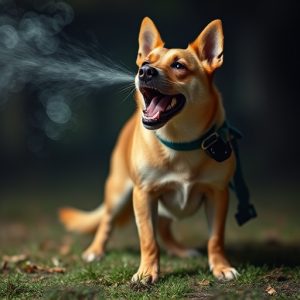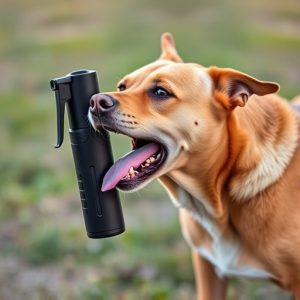Police-Grade Canine Pepper Spray: Composition, Safety, and Longevity in Your Car
Canine pepper spray, with a 2-3 year shelf life, requires proper storage (cool, dark places like glo…….
Canine pepper spray, with a 2-3 year shelf life, requires proper storage (cool, dark places like glove compartments) and regular checks to maintain potency. Police-grade sprays, more potent than consumer versions, still degrade over time due to heat, sunlight, humidity, and moisture; adhering to manufacturer guidelines is crucial. Legal regulations vary by region regarding pepper spray possession, so understanding local laws and storing it securely is essential for self-defense without legal repercussions.
“Unleashing the power of pepper spray, specifically tailored for canine use, has emerged as a critical tool in law enforcement strategies. This article delves into the intricacies of canine pepper spray, exploring its composition and effectiveness. We compare police-grade formulations with consumer versions, shedding light on key differences. Furthermore, we examine factors impacting shelf life, emphasize proper storage and maintenance for optimal efficacy, and discuss safety considerations along with legal aspects of carrying pepper spray in your vehicle.”
- Understanding Canine Pepper Spray: Composition and Effectiveness
- Police-Grade Pepper Spray vs. Consumer Versions
- Factors Affecting Pepper Spray Shelf Life
- Storage and Maintenance for Optimal Efficacy
- Safety Considerations and Legal Implications of Carrying Pepper Spray
Understanding Canine Pepper Spray: Composition and Effectiveness
Canine pepper spray, a powerful tool for law enforcement and search and rescue dogs, is designed to incapacitate and deter potential threats. It’s crucial to understand its composition to grasp its effectiveness and safety considerations. This police-grade spray typically contains capsaicin, the active ingredient found in chili peppers, blended with other chemicals to enhance its potency and duration. The formula is carefully crafted to ensure a strong irritant effect without causing permanent harm.
The pepper spray’s shelf life in a car or any storage area is an essential factor to consider for optimal performance. Under ideal conditions, it usually lasts between 2-3 years. However, exposure to extreme temperatures, sunlight, and humidity can significantly impact its stability. Regular checking and proper storage are vital to maintain its potency. Users should follow the manufacturer’s guidelines for shelf life and storage practices to ensure they have a reliable tool when needed.
Police-Grade Pepper Spray vs. Consumer Versions
Police-grade pepper spray is specifically designed for law enforcement officers, offering a more potent and durable solution compared to consumer versions. While consumer pepper spray is readily available and often used for personal protection, its effectiveness may vary greatly. Police-grade sprays are subject to stringent testing standards, ensuring they meet specific criteria for stopping an assailant with minimal risk to bystanders. These professional-level products typically have a longer shelf life and better resilience against harsh environmental conditions, making them reliable tools in high-stress situations.
In terms of storage, keeping pepper spray in the car is a common practice, but it requires careful consideration. The ideal location should be secure, cool, and away from direct sunlight or extreme heat. In vehicles, the dashboard or under a seat are popular choices due to accessibility. However, remember that even police-grade pepper spray has a limited shelf life; proper storage conditions can help maintain its potency. Always check expiration dates and follow manufacturer guidelines for optimal performance, especially if you’re relying on it for personal safety during road trips or in case of emergencies.
Factors Affecting Pepper Spray Shelf Life
The pepper spray shelf life in a car, or any vehicle, is influenced by several factors. One of the primary considerations is temperature. Extreme heat can significantly reduce the effectiveness of pepper spray, so storing it in a cool, controlled environment within your vehicle is essential. Additionally, exposure to light, especially direct sunlight, can degrade the active ingredients over time, making it less potent when needed. The level of humidity inside the car matters too; high humidity might cause moisture buildup, which can damage the spray’s packaging and potentially reduce its potency.
Another factor affecting pepper spray shelf life is how it’s stored within your car. If left unsecured, it could move around during transportation, leading to potential damage or leakage. It’s recommended to keep it in a dedicated, sealed container, preferably mounted to a fixed part of the vehicle to prevent shifting. Moreover, ensuring proper ventilation inside the car can help maintain optimal storage conditions, prolonging the spray’s viability when you need it most.
Storage and Maintenance for Optimal Efficacy
Storing canine pepper spray properly is crucial for maintaining its optimal efficacy. This includes keeping it out of direct sunlight, extreme heat or cold, and in a dry place. Many manufacturers recommend storing pepper spray in a cool, dark location, such as a glove compartment or dashboard of your car, away from any flammable materials. The Pepper Spray Shelf Life in Car can be significantly extended by adhering to these guidelines.
Regular maintenance is also essential. Ensure the canister is always sealed tightly after each use to prevent evaporation and maintain its potency. Check for any signs of damage, such as dents or leaks, which could compromise the spray’s effectiveness. Additionally, familiarize yourself with the expiration date or ‘use-by’ date marked on the product, as pepper spray can lose its potency over time, even if stored properly.
Safety Considerations and Legal Implications of Carrying Pepper Spray
Carrying pepper spray, especially police-grade varieties, comes with significant safety considerations and legal implications. It’s crucial to understand that pepper spray is a powerful tool designed for law enforcement and self-defense professionals—not everyday citizens. Improper use can result in severe consequences, including respiratory distress, pain, and even temporary blindness. Therefore, thorough training on usage and handling is essential before considering its possession.
Legally, the regulations surrounding pepper spray vary by jurisdiction. Some areas permit civilians to carry pepper spray for self-defense, while others restrict it to licensed professionals only. Additionally, there are specific rules regarding storage and shelf life of pepper spray in cars, such as keeping it out of reach of children and storing it in a secure, labeled container. Ignoring these guidelines can lead to legal penalties, so it’s vital to be aware of the local laws before purchasing and carrying this type of self-defense weapon.
Canine pepper spray, especially police-grade varieties, is a powerful tool designed for law enforcement. When properly stored and maintained, it can offer significant protection, but understanding its shelf life and safety considerations is crucial. Regular maintenance and storage in ideal conditions are key to ensuring its effectiveness, particularly when kept in your car for emergency situations. Remember, knowledge of local legal implications and safe handling practices are essential before carrying any pepper spray.

